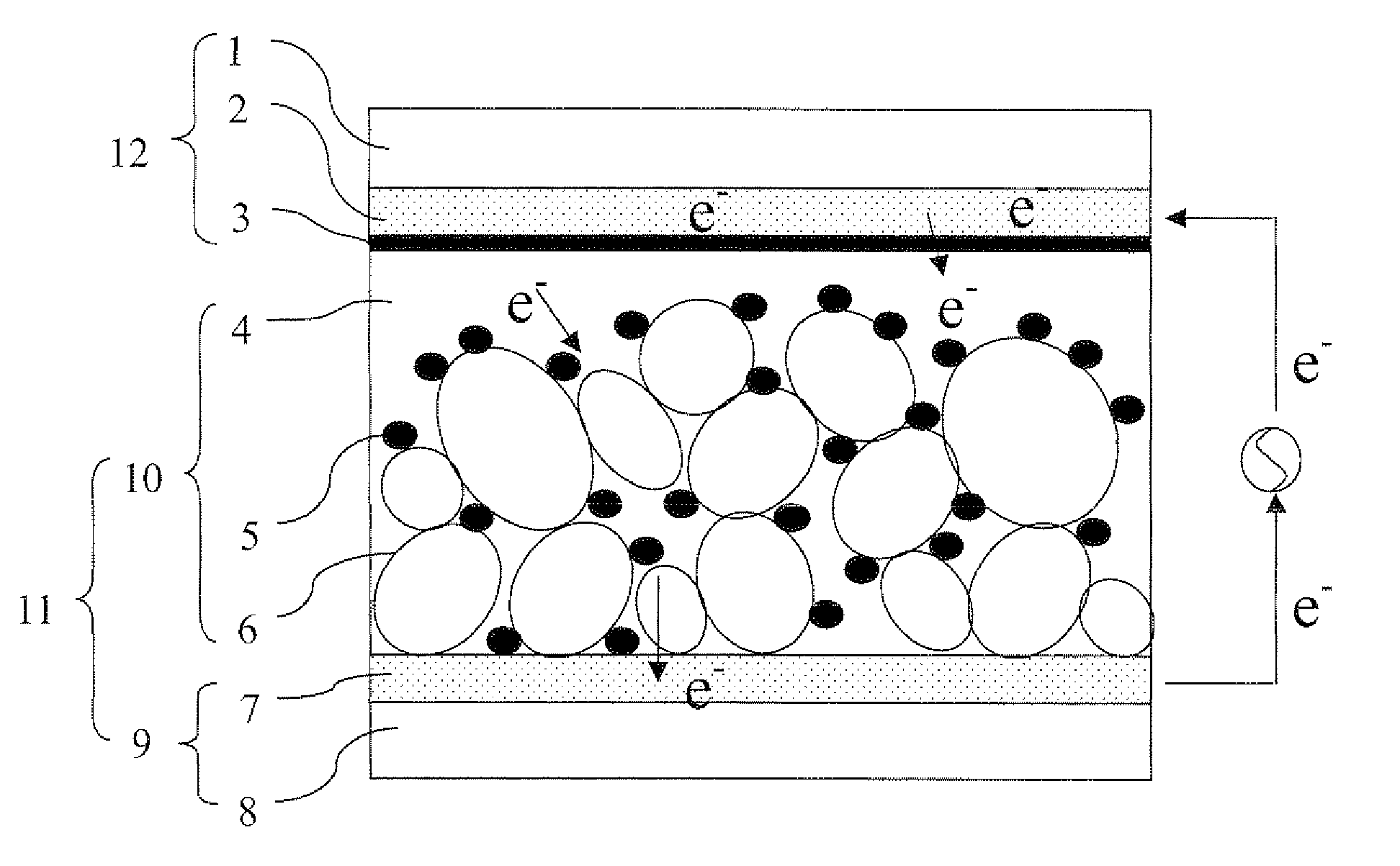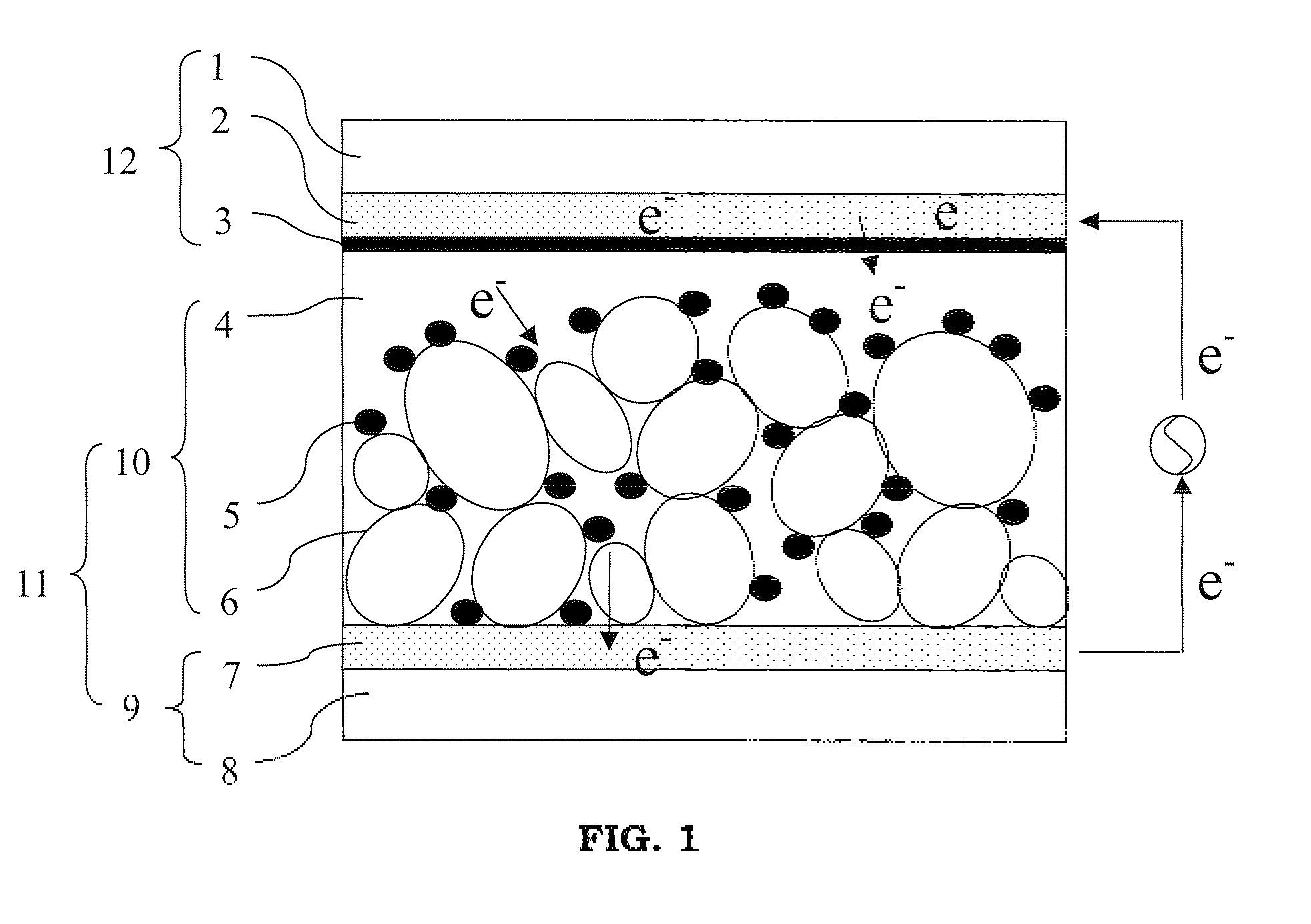Pyridine type metal complex, photoelectrode comprising the metal complex, and dye-sensitized solar cell comprising the photoelectrode
a metal complex and metal complex technology, applied in the direction of ruthenium organic compounds, osmonium organic compounds, semiconductor/solid-state device details, etc., to achieve the effect of excellent stability and wide absorption band
- Summary
- Abstract
- Description
- Claims
- Application Information
AI Technical Summary
Benefits of technology
Problems solved by technology
Method used
Image
Examples
example 1
(1) Synthesis of Ruthenium Complex
(a) Synthesis of 2-(2′-methylphenyl)-4-methylpyridine
[0126]
[0127]2-tributylstannylpyridine (6.02 g, 16.3 mmol), 1-bromo-2-methylbenzene (6.63 g, 38.8 mmol) and Pd(PPh3)4 (0.613 g, 0.003 equivalent) were refluxed in toluene (150 mL) and under an argon atmosphere for 72 hours. Next, the obtained solution was cooled to room temperature, the reaction system was concentrated, 6M-HCl (50 ml) was added, and extraction with methylene chloride (100 mL) was carried out three times to remove components such as raw materials and pyridyl derivatives as byproducts. Successively, an aqueous ammonium solution (28%) was added to the obtained water phase to neutralize the water phase. Continuously, an excess amount of NiCl2-6H2O was added to the obtained solution and extraction with methylene chloride (100 mL) was carried out three times to obtain a brown solution. Next, the obtained brown solution was dried with Na2SO4 and filtered with filter paper and the filtrate...
example 2
(1) Synthesis of Ruthenium Complex
(a) Synthesis of Bipyridine Ligand Represented by Formula (45)
[0141]
[0142]Under an argon atmosphere, a solution of 2.0 M-lithium diisopropylamide (LDA) in THF (2.5 mL, 5 mmol) was slowly added dropwise to a solution of 4,4-dimethylbipyridine (0.5 g, 2.48 mmol) in anhydrous THF (80 mL, −78° C.). Next, after the obtained reaction system was stirred at −40° C. for 30 minutes, a solution of a thiophene ligand (0.98 g, 5.0 mmol) in THF (50 mL) was added and the mixture was further stirred for 6 hours and then the reaction system was heated to room temperature. Successively, water (100 mL) and dichloromethane (200 mL) were added to the obtained reaction system to carry out phase separation. The obtained organic layer product was dissolved in dichloromethane (100 mL) and, trifluoroacetic anhydride (TFAA, 2 mL, 14.3 mmol) was added thereto and the mixture was allowed to react for 12 hours. The obtained product was refined by an aluminum column (dichlorometh...
example 3
(1) Synthesis of Ruthenium Complex
(a) Synthesis of Ruthenium Complex Represented by Formula (68)
[0150]
[0151]RuCl2 (14.5 mg, 0.07 mmol) was added to a solution of tricarboxyterpyridine (25.6 mg, 0.07 mmol) in DMF and the obtained reaction system was refluxed for 4 hours. Next, the ligand (227.8 mg, 0.35 mmol) represented by the formula (44) was added to the obtained reaction system and the mixture was refluxed further for 24 hours. Finally, N(C4H9)4NCS (105.2 mg, 0.35 mmol) was added to the obtained reaction system and the mixture was refluxed for 24 hours. Refining was carried out using a column (Sephadex LH-20) (methanol) to obtain a ruthenium complex represented by the formula (68) (yield: 55%).
[0152]Analysis results were as follows.
C90H121N7O6RuS5:[0153]Calculated value: C 65.18; H 7.35; N 5.91[0154]Experimental value: C 65.10; H 7.30; N 5.89[0155]MS (ESIMS): m / z: 1658 (M)
(2) Production of Electrode Containing Photoelectric Conversion Device and Dye-Sensitized Solar Cell
[0156]An ...
PUM
| Property | Measurement | Unit |
|---|---|---|
| partial structure | aaaaa | aaaaa |
| structure | aaaaa | aaaaa |
| semiconductor | aaaaa | aaaaa |
Abstract
Description
Claims
Application Information
 Login to View More
Login to View More - R&D
- Intellectual Property
- Life Sciences
- Materials
- Tech Scout
- Unparalleled Data Quality
- Higher Quality Content
- 60% Fewer Hallucinations
Browse by: Latest US Patents, China's latest patents, Technical Efficacy Thesaurus, Application Domain, Technology Topic, Popular Technical Reports.
© 2025 PatSnap. All rights reserved.Legal|Privacy policy|Modern Slavery Act Transparency Statement|Sitemap|About US| Contact US: help@patsnap.com



